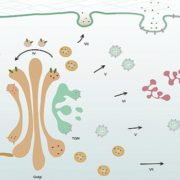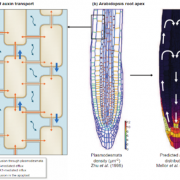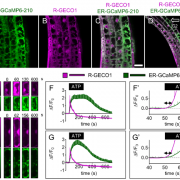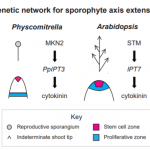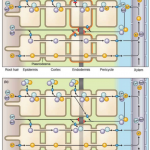Cytoskeleton dynamics necessary for early events of lateral root initiation (Curr. Biol.)
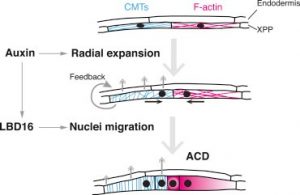 Symmetric cell division leads to proliferation, and asymmetric cell division establishes differential growth. Formation of lateral roots (LRs) depends on asymmetric division of initially symmetric founder cells. Barro et al. studied the mechanism of asymmetric radial expansion by analyzing cytoskeleton dynamics using mutants, pharmacological drugs, and tissue-specific perturbation. They expressed MAP4 (MICROTUBULE-ASSOCIATED PROTEIN4) specifically in founder cells using the GATA23 promoter and showed that asymmetric expansion of LR founder cells coincides with nuclear migration and microtubule re-orientation. Furthermore, microtubule destabilizing (oryzalin) and stabilizing (taxol) drugs revealed that microtubules are required for asymmetric radial expansion. Using tissue-specific genetic perturbation of auxin response, the authors found that auxin signaling plays critical roles for radial expansion and the reorganization of microtubules. They also showed that when actin networks are depolymerized, the nucleus doesn’t migrate in the founder cells so a symmetric division happens instead of asymmetric division. This article suggests that auxin signaling contributes to LR initiation through the co-ordination of F-actin dynamics for nuclear movement and microtubule re-orientation for asymmetric radial expansion in the founder cell. (Summary by Arif Asraf) Curr. Biol. 10.1016/j.cub.2019.06.039
Symmetric cell division leads to proliferation, and asymmetric cell division establishes differential growth. Formation of lateral roots (LRs) depends on asymmetric division of initially symmetric founder cells. Barro et al. studied the mechanism of asymmetric radial expansion by analyzing cytoskeleton dynamics using mutants, pharmacological drugs, and tissue-specific perturbation. They expressed MAP4 (MICROTUBULE-ASSOCIATED PROTEIN4) specifically in founder cells using the GATA23 promoter and showed that asymmetric expansion of LR founder cells coincides with nuclear migration and microtubule re-orientation. Furthermore, microtubule destabilizing (oryzalin) and stabilizing (taxol) drugs revealed that microtubules are required for asymmetric radial expansion. Using tissue-specific genetic perturbation of auxin response, the authors found that auxin signaling plays critical roles for radial expansion and the reorganization of microtubules. They also showed that when actin networks are depolymerized, the nucleus doesn’t migrate in the founder cells so a symmetric division happens instead of asymmetric division. This article suggests that auxin signaling contributes to LR initiation through the co-ordination of F-actin dynamics for nuclear movement and microtubule re-orientation for asymmetric radial expansion in the founder cell. (Summary by Arif Asraf) Curr. Biol. 10.1016/j.cub.2019.06.039




